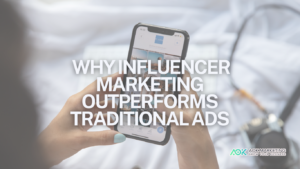Influencer marketing has emerged as a game-changing strategy for brands aiming to build awareness, trust, and loyalty among their target audience. Unlike traditional ads, which often feel impersonal and intrusive, influencer marketing leverages authentic relationships between influencers and their followers. As a result, this form of marketing can drive more engagement, sales, and long-term customer relationships.
This article will explore why influencer marketing is so effective, how brands can leverage it, and what the future holds for this powerful strategy.
1. What is Influencer Marketing?
Influencer marketing is a type of social media marketing where brands partner with individuals who have established credibility and influence in a specific niche. These influencers, ranging from celebrities to everyday consumers with loyal followings, promote products or services on platforms like Instagram, TikTok, YouTube, and Twitter.
Unlike traditional ads that focus on selling, influencer marketing relies on authentic recommendations and endorsements, creating a more trustworthy form of word-of-mouth marketing. Since influencers often cater to niche audiences, brands can target their marketing efforts with precision.
2. Why is Influencer Marketing So Effective?
Influencer marketing thrives on several key factors that make it more effective than traditional advertising:
A. Authenticity
One of the core reasons influencer marketing outperforms traditional ads is its authenticity. Followers trust influencers because they perceive them as real people with relatable lives and genuine opinions. When an influencer endorses a product, it feels more like a personal recommendation rather than a sales pitch, leading to higher engagement and conversion rates.
B. Targeted Reach
Influencers often have niche audiences that align with specific interests or demographics. Brands can partner with influencers who share a similar audience profile, ensuring that their marketing message reaches the right people. This level of precision targeting is often more effective than casting a wide net with traditional ads.
C. Higher Engagement
Influencers typically have higher engagement rates than corporate social media accounts. Their followers are more likely to like, comment on, and share content. By partnering with influencers, brands can increase visibility, foster meaningful interactions, and ultimately create a deeper connection with their audience.
D. Social Proof
Social proof is a psychological phenomenon where people are influenced by the actions and endorsements of others. When influencers promote a product, their followers often see it as a stamp of approval, making the product more desirable and trustworthy. This creates a ripple effect, with more people wanting to try the product simply because their favorite influencer recommends it.
3. Types of Influencers
Choosing the right type of influencer for a marketing campaign is crucial for success. Influencers are often categorized into four main groups:
A. Mega-Influencers
Mega-influencers have massive followings, usually over 1 million on platforms like Instagram or TikTok. They are often celebrities or well-known public figures. While they offer significant reach, their content can feel less personal, and their fees tend to be high.
B. Macro-Influencers
With followers ranging from 100,000 to 1 million, macro-influencers typically have strong authority in their niche. They generate high levels of engagement and are ideal for brands aiming to reach a broad but targeted audience.
C. Micro-Influencers
Micro-influencers have between 10,000 and 100,000 followers and often maintain personal relationships with their audience. This makes their content feel more authentic and relatable. Micro-influencers are valuable for brands looking to build trust and drive engagement through niche audiences.
D. Nano-Influencers
Nano-influencers have fewer than 10,000 followers but boast hyper-engaged communities. They are ideal for smaller, localized campaigns where personal connection and authenticity outweigh sheer reach.
4. How to Create a Successful Influencer Marketing Strategy
To maximize the impact of influencer marketing, brands must develop a well-rounded strategy. Here’s a step-by-step guide to help brands achieve success:
A. Define Your Campaign Goals
Before reaching out to influencers, determine the main objectives of your campaign. Are you aiming to increase brand awareness, drive sales, grow your social media following, or boost website traffic? Your goals will influence the type of influencers you partner with and the content you create.
B. Identify the Right Influencers
Finding the right influencers is key to a successful campaign. Look for influencers who align with your brand’s values, whose audience matches your target demographic, and who produce content that resonates with your ideal customer.
C. Set a Budget and Negotiation Terms
Influencer fees vary widely based on their following, platform, and the scope of the collaboration. Decide on a budget that includes influencer compensation, content creation costs, and any platform or agency fees. Negotiating clear terms upfront will help set expectations and avoid misunderstandings later.
D. Craft Authentic Campaigns
Give influencers creative freedom to create content that feels authentic to their audience. While it’s essential to communicate your brand message and campaign goals, overly scripted content may come across as disingenuous. Allow influencers to integrate your product into their lifestyle naturally.
E. Measure Success
Track relevant metrics to measure the success of your influencer campaign. Metrics like engagement rates (likes, comments, shares), click-through rates (CTR), and sales conversions are essential indicators. Many social platforms offer analytics tools, and influencers can provide performance metrics from their posts.
5. Common Influencer Marketing Mistakes to Avoid
While influencer marketing is effective, certain missteps can diminish its impact. Here are some common mistakes and how to avoid them:
Focusing Solely on Follower Count
Follower count is not the sole indicator of an influencer’s value. Engagement rates and audience quality are more critical. A smaller but highly engaged audience will yield better results than a larger, disengaged one.
Lack of Clear Communication
Ensure that influencers understand your brand’s message and campaign objectives. Clear communication is vital to aligning expectations and producing high-quality content.
Ignoring FTC Guidelines
Influencers are required to disclose paid partnerships under FTC guidelines. Failure to comply can damage both the influencer’s and the brand’s reputation. Ensure transparency to maintain trust with the audience.
One-Off Collaborations
Long-term partnerships are more effective than one-off campaigns. Building relationships with influencers over time allows for consistent brand messaging and fosters a more authentic connection with their followers.
6. The Future of Influencer Marketing
As the digital landscape continues to evolve, several trends are shaping the future of influencer marketing:
A. AI-Driven Influencers
Artificial intelligence is creating virtual influencers—digital personas that can engage audiences like human influencers. These AI-driven influencers offer brands a new way to advertise and interact with consumers.
B. Video Dominance
With platforms like TikTok and Instagram Reels growing in popularity, short-form video content is becoming the preferred medium for influencer campaigns. Brands should prioritize video content to stay relevant and increase engagement.
C. Focus on Authenticity
Consumers are becoming savvier and can easily spot inauthentic content. Moving forward, authenticity will remain crucial to the success of influencer marketing campaigns.
Conclusion
Influencer marketing has proven to be one of the most powerful strategies for brands looking to connect with their audience in authentic and meaningful ways. By collaborating with the right influencers and creating genuine, targeted campaigns, brands can reach new heights of engagement, sales, and brand loyalty. As influencer marketing continues to evolve, it will remain a key path to success in the digital marketing world.
About The Author
Marketing Team
The AOK Marketing Team is a diverse group of amazing individuals driven to help all of our clients succeed. Great people are everywhere, and we believe that people should control their workday, their work environment, and where they live. We have team members in 9 countries: United States, Canada, Egypt, Belgium, Ireland, Australia, India, Pakistan, and Hong Kong.
How can we help you?






